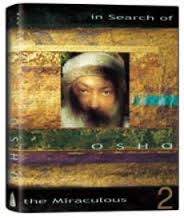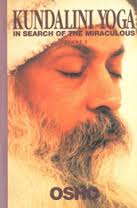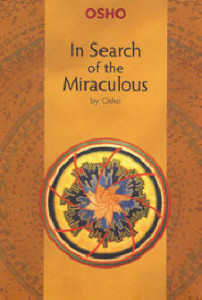Many of us love to talk and read about energy bodies, chakras, and tantra, but how many of us really understand how to use these as tools for real transformation in our lives?
This is an unusual and fascinating read for anyone who is interested in the practical application of the esoteric aspects of mysticism, and the science of human energy as it is understood in the East.
Transfer of Energy
During this series, Osho is in the process of developing his revolutionary Dynamic Meditation, and responding to questions about many facets of his work including kundalini energy and shaktipat, the transfer of energy from an awakened one to a seeker of truth.
All the techniques in this book can help us experience miraculous moments when our energy expands and takes us into something far beyond the known.
In Search of the Miraculous Nederlands
Het boek In Search of the Miraculous: er zijn niet veel lezingenseries van Osho die hij puur aan het esoterische heeft gewijd. Verspreid door zijn werk is er natuurlijk genoeg over te vinden, maar dat wordt dan wel een  langdurige zoektocht. En hier staat het allemaal mooi bij elkaar. In dit boek kun je alles vinden over de seven bodies en de chakra’s
langdurige zoektocht. En hier staat het allemaal mooi bij elkaar. In dit boek kun je alles vinden over de seven bodies en de chakra’s
die hiermee corresponderen.
Tijdens deze lezingen was Osho bezig de dynamische meditatie te ontwikkelen. En je vindt dan ook vragen beantwoord over thema’s als shaktipat, kundalini energie en energieoverdracht. Verder staan er interessante technieken in het boek om ons te helpen onze ‘miraculeuze momenten’ te versterken en uit te breiden.
Het boek In Search of the Miraculous in verkrijgbaar bij de Boekhandel.
Review van In Search of the Miraculous
Als het leven de kenmerken krijgt van sleur, gaan we op zoek naar avontuur.
Het is natuurlijk en wel zó natuurlijk, dat je het al bij kleine kinderen kunt waarnemen.
De box is een leuk speelterrein, maar als je die kent, wil je eraan ontsnappen om de wereld buiten de box te verkennen.
Op verkenning gaan levert een nieuwe kleurrijke wereld op.
Maar je moet dan wel geleerd hebben om gevoelig te zijn voor kleuren.
Verder moet je het lef hebben om het onbekende in te gaan.
En ook dien je over een grote dosis energie en volharding te beschikken.
Het kind op de Zen Tarot kaart maakt wankele stapjes, maar betreedt vastberaden de wereld van kleur.Ons pad in de wereld van meditatie is vergelijkbaar met wat we dit kind op avontuur zien doen.
En zo mogelijk wordt er nog wel iets meer van ons geëist op het meditatieve pad dan van het kind.
Osho vertelt hier alles over in: ‘In Search of the Miraculous’, het boek dat lange tijd niet meer verkrijgbaar was. Nadat het in 1970 voor het eerst verscheen, zijn delen ervan bij andere uitgeverijen uitgekomen.
En sinds begin 2009 staat het boek weer in totaliteit in de schappen.
Het is een lijvig werk, een mooi gebonden naslagwerk.
Er staat veel informatie in over de energiecentra, de chakra’s en die zijn ook betoverend mooi afgebeeld.
Als oplichtende bronnen hebben ze hun eigen specifieke kleur op de afbeelding in het boek.
En als draaiend energiecentrum is een chakra weergegeven op de cover van het boek, althans zoals deze voorgesteld kan worden.
Het mooie is, dat het hier niet om een theoretische verhandeling gaat, zoals er zovele op dit gebied zijn.
Nee, het boek ‘In Search of the Miraculous’ komt rechtstreeks uit de praktijk.
Osho leidt een meditatiekamp en aan de hand van vragen van de deelnemers behandelt hij zaken als: chakra’s, shaktipat, de energielichamen en nog veel meer.
Uiteraard blijft het niet bij het louter beantwoorden van vragen, maar neemt Osho de gelegenheid te baat om zijn eigen inzichten te presenteren.
Meditatie is absoluut de kern van Osho’s visie.
Het is het instrument bij uitstek dat hij aanreikt voor bewustwording en transformatie.
Alle andere methodes zoals therapie, bodywork en welke healing methode dan ook dienen, volgens hem, in dienst te staan van meditatie.
En als Osho in deze lezingenserie over het meditatieve pad spreekt, wijst hij op de hindernissen die wij ontmoeten en waarvan we ons meestal niet bewust zijn.
Zo geeft Osho aan, dat we niet in een wereld leven die aanzet tot het ontwikkelen van religieus besef.
Dit religieuze besef, de verbondenheid ervaren van alles met elkaar en het je geborgen weten in het Bestaan, is eenvoudig niet aanwezig.
Je gaat in meditatie dus op zoek naar iets wat je niet kent en waar je ook de voelhorens niet voor hebt ontwikkeld.
Een jong kind dat op avontuur uitgaat, is tot op zekere hoogte voorbereid op wat het kan gaan aantreffen. Het heeft er de verhalen over gehoord.
Dat is bij de huidige mens die zich in meditatie begeeft niet het geval.
Het is goed om dat te weten als mediterende en ook om dat te delen met andere mensen op dit pad.
Daarom levert meditatie in groepsverband ook zo’n speciale dimensie op.
Ik heb het Osho meermalen horen zeggen: we zijn ons er niet van bewust hoeveel kracht het kost om ons innerlijk wezen te vinden.
Het ligt onder zoveel lagen stof verborgen, er zijn zoveel door conditionering ingesleten trucs die ons afgesneden houden van ons innerlijk… dat er onmetelijke inspanning vereist is.
Osho trekt in dit boek de vergelijking met een hardloper die zijn prestaties alsmaar opvoert
Maar het uiteindelijke resultaat dat de hardloper neerzet is bij lange na nog niet genoeg voor wat er bij meditatie gevraagd wordt.
Er is angst om onze totale levensenergie, de kundalini, te laten ontwaken. “ Wat is het gevaar eigenlijk om dit te laten gebeuren?” is de vraag van een zoeker ”en waarom zouden we dit doen, als het zo gevaarlijk is?” Osho legt uit, dat in meditatie de dood verborgen zit. Als je mediteert, sterft er telkens een stukje van je verleden af. En dat maakt angstig. Het is de angst van de rivier om tot oceaan te worden. En het is dezelfde angst van een stukje kool voordat dit tot diamant wordt.
Het is de angst van de rivier om tot oceaan te worden. En het is dezelfde angst van een stukje kool voordat dit tot diamant wordt.
Het leven houdt zonder meer gevaar in als je het ten volle durft te leven.
Allerlei zekerheden en veiligheidskleppen maken ons meer dood dan levend, terwijl we zogenaamd in leven zijn.
En hierbij vertelt Osho het indringende verhaal over de koning die een zeer speciaal paleis liet bouwen.
Een bedelaar die buiten zat gaf daarbij het ultieme veiligheidsadvies.
In dit boek raak je voorlopig niet uitgelezen en daarna zul je het nog regelmatig opslaan om de kwintessens van het miraculeuze in het leven beter te kunnen vatten. Het is een prachtige basis en ondersteuning op het meditatieve pad.
Impressie van In Search of the Miraculous
Question: “In yesterday’s talk you said that the seeker should first worry about his own receptivity and should not go begging from door to door. But the very meaning of a sadhak is that there are obstacles on his path of spiritual growth. He does not know how to be receptive. Is it so difficult to meet the right guide?”
“To seek and to ask are two different things. Actually, only he who does not want to seek asks. To seek and to ask are not one and the same; rather, they are contradictory. He who wants to avoid seeking asks. The process of seeking and the process of begging are very different. In asking the attention is centered on the other — on the giver; in seeking the attention is centered on oneself — on the receiver. To say that there are obstacles in the path of spiritual growth means there are obstacles within the seeker himself. The path too lies within and it is not very difficult to understand one’s own hindrances. It will have to be explained at length what obstacles are and how they can be removed. Yesterday I told you about the seven bodies. We shall talk in greater detail about these and it will become clear to you”
“As there are seven bodies, so there are also seven chakras, energy centers, and each chakra is connected in a special way with its corresponding body. The chakra of the physical body is the muladhar. This is the first chakra and it has an integral connection with the physical body. The muladhar chakra has two possibilities. Its first potentiality is a natural one that is given to us with birth; its other possibility is obtainable by meditation.”
The basic natural possibility of this chakra is the sex urge of the physical body. The very first question that arises in the mind of the seeker is what to do in regard to this central principle. Now there is another possibility of this chakra, and that is brahmacharya, celibacy, which is attainable through meditation. Sex is the natural possibility and brahmacharya is its transformation. The more the mind is focused upon and gripped by sexual desire, the more difficult it will be to reach its ultimate potential of brahmacharya.”
Now this means that we can utilize the situation given to us by nature in two ways. We can live in the condition that nature has placed us in — but then the process of spiritual growth cannot begin — or we transform this state. The only danger in the path of transformation is that there is the possibility that we may begin to fight with our natural center. What is the real danger in the path of a seeker? The first obstacle is that if the meditator indulges only in nature’s order of things he cannot rise to the ultimate possibility of his physical body and he stagnates at the starting point. On the one hand there is a need; on the other hand there is a suppression which causes the meditator to fight the sex urge. Suppression is an obstacle on the path of meditation. This is the obstacle of the first chakra. Transformation cannot come about with  suppression. ‘In Search of the Miraculous”
suppression. ‘In Search of the Miraculous”
If suppression is an obstruction, what is the solution? Understand-ing will then solve the matter. Transformation takes place within as you begin to understand sex. There is a reason for this. All elements of nature lie blind and unconscious within us. If we become conscious of them, transformation begins. Awareness is the alchemy; awareness is the alchemy of changing them, of transforming them. If a person becomes awake toward his sexual desires with his total feelings and his total understanding, then brahmacharya will begin to take birth within him in place of sex. Unless a person reaches brahmacharya in his first body it is difficult to work on the potentiality of other centers.
The second body, as I said, is the emotional or the etheric body. The second body is connected to the second chakra — the swadhishthan chakra. In Search of The Miraculous
The third is the astral body. This also has two dimensions. Primarily, the third body revolves around doubt and thinking. If these are transformed doubt becomes trust and thinking becomes vivek, awareness.
The fourth plane is the mental body or the psyche, and the fourth chakra, the anahat, is connected with the fourth body. The natural qualities of this plane are imagination and dreaming. This is what the mind is always doing: imagining and dreaming. It dreams in the night and in the daytime it daydreams.
The fifth chakra is the vishuddhi chakra. It is located in the throat. The fifth body is the spiritual body. The vishuddhi chakra is connected to the spiritual body. The first four bodies and their chakras were split into two. The duality ends with the fifth body.
The sixth is the brahma sharira, the cosmic body, and the sixth chakra is the agya chakra. Here there is no duality. The experience of bliss becomes intense on the fifth plane and the experience of existence, of being, on the sixth. Asmita will now be lost — I am. The I in this is lost at the fifth plane and the am will go as soon as you transcend the fifth. The is-ness will be felt; tathata, suchness will be felt.
Then one day you will step into the seventh body, where being and nonbeing, light and darkness, life and death, occur together. That is the attainment of the ultimate… and there are no means of communicating this state.” Osho, In Search of The Miraculous
